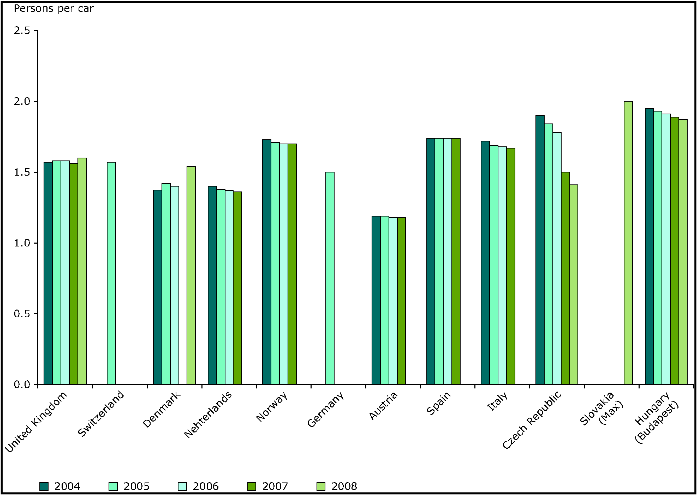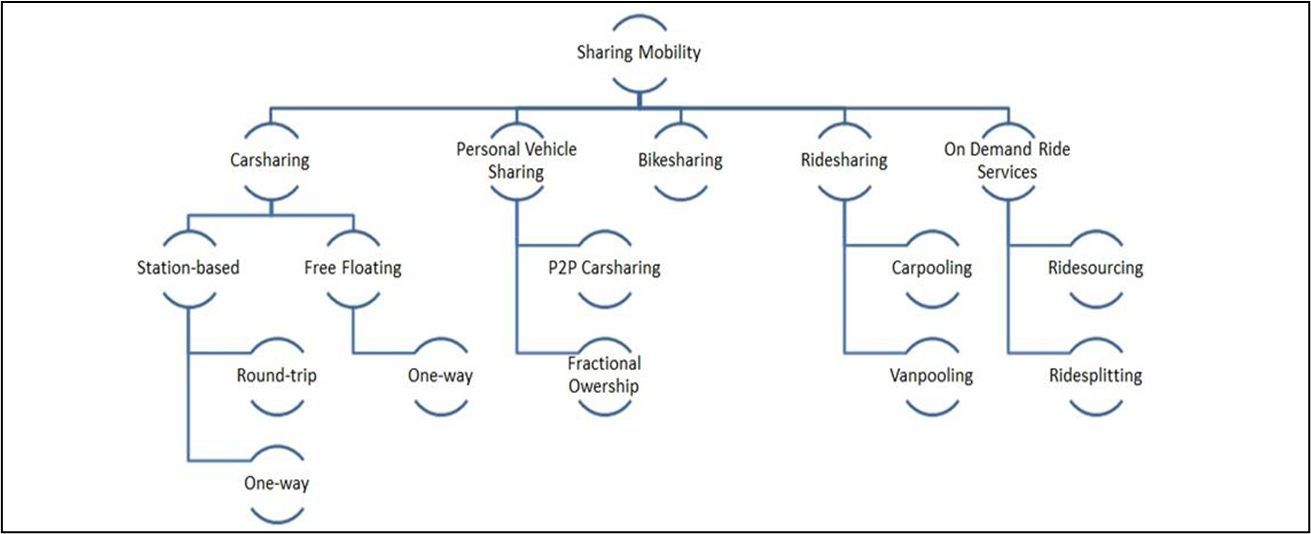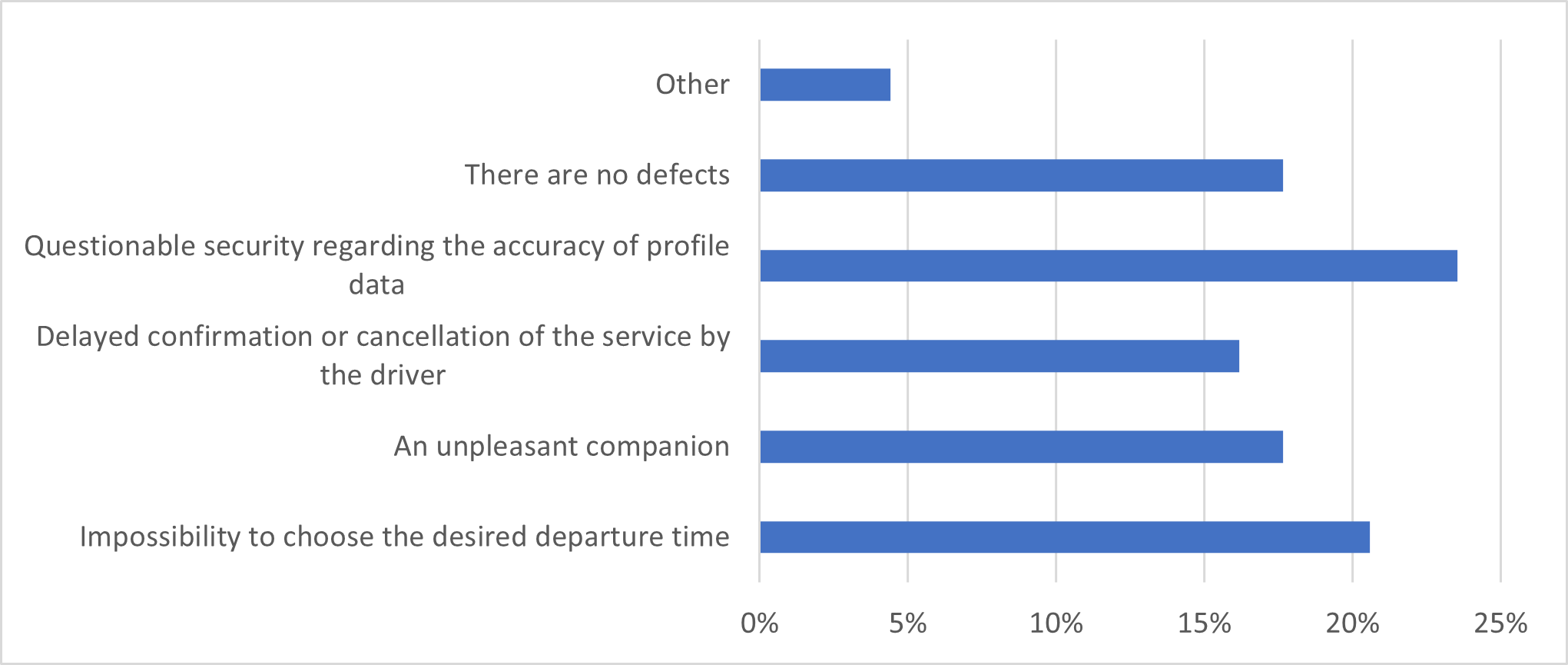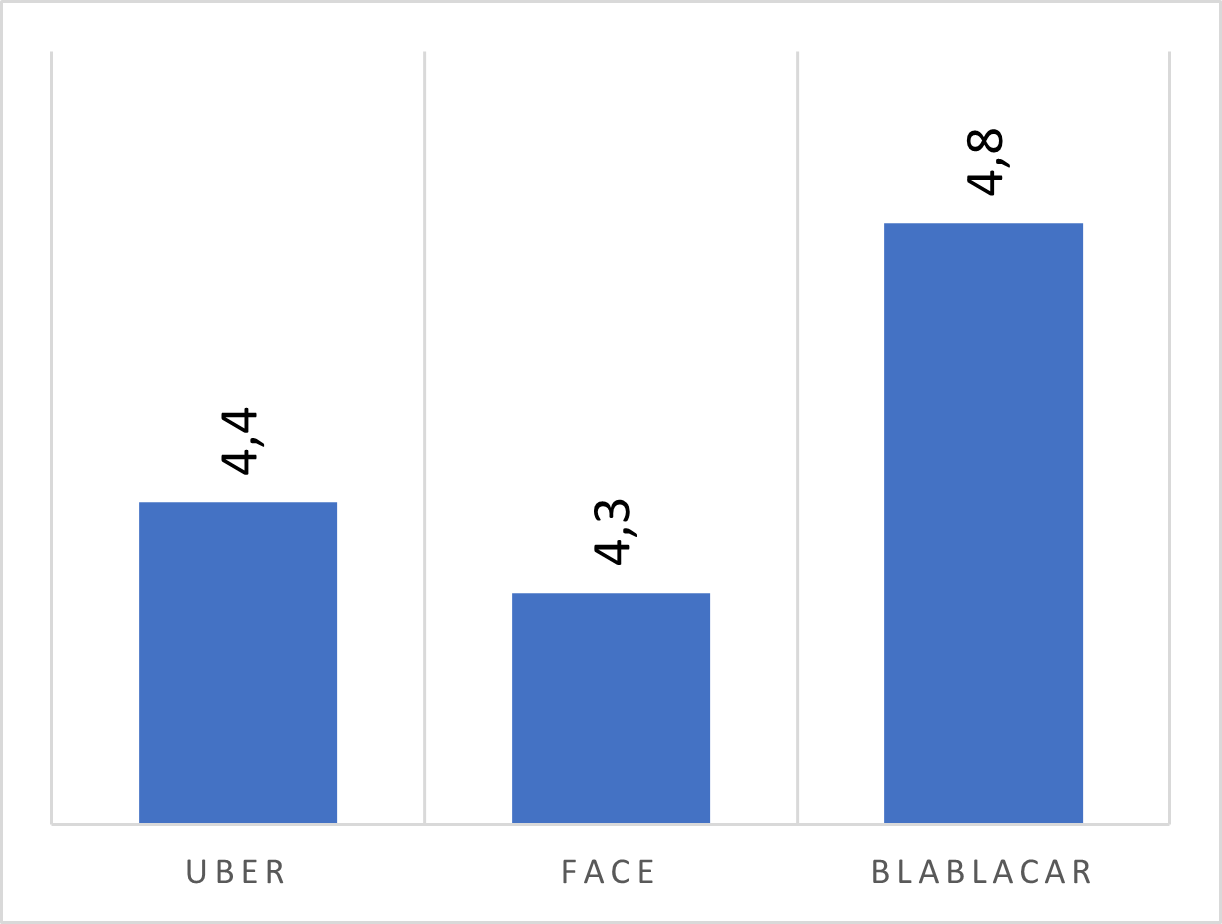1. INTRODUCTION
Mobility is the basis of economic and social activities, and the efficiency of the transportation system is a key determinant of the success of economic development and the quality of life of the population. In today’s globalized and highly urbanized world, the challenges are becoming increasingly evident. One of the problems is the excessive growth of road traffic, which threatens economic productivity and the environment and limits mobility and thus the quality of life of the population, especially in urban areas. The solutions proposed and initiatives implemented vary, but all have, or should have, a common basis, which is to reduce the use of private vehicles. Reducing emissions or eliminating internal combustion engines altogether and replacing them with electric drives may have an impact on environmental sustainability, but it does not solve the problem of the sustainability of transport and therefore of the economic system. The question, however, is how to reduce the use of the car, even though it is so practical and attractive because of its flexibility, comfort, affordability, availability, and so on. The answer to these different demands could be offered by the sharing economy. A great potential becomes clear if one looks at the problem from a different angle, namely not the sheer number of cars, but the efficiency and type of their use. Most of the time, cars are parked somewhere and actually used according to their specific purpose and destination, often less than 5% of the time, with very low utilization of actual capacity. (Bates, Leibling, 2012) Therefore, the current mobility needs of the population could be met with a much smaller fleet of vehicles if the available time and vehicle capacity were better utilized. In this way, the fundamental objective of reducing the number of cars due to their negative impact would be achieved, while maintaining the expected level of mobility of the population.
The phenomenon of the sharing economy has opened up space for more efficient use of transport, faster availability, i.e. the exchange of available transport resources between different actors, solving the problem of sustainable mobility in urban areas, supported by various digital platforms. According toMouratidies et al. (2021), carsharing could reduce private car use, private car ownership, miles traveled, etc. Although carsharing is not intended to replace regular private vehicle use, it could lead to more people walking, biking, and using public transportation. Ridesharing can increase mobility for low-income workers, single people, and women, increase car utilization, provide an alternative to owning a second car, etc. (Mouratidies et al., 2021). The development of ICT technology has a direct impact on the development potential of specialized digital platforms, which can become more attractive and accessible to end users and thus have a direct impact on increasing shared mobility, i.e., on changing individual travel behavior.
The aim of this paper is to analyze the key challenges of the sharing economy in the transport sector, in particular shared mobility, and the role of specialized digital platforms in connecting users and providers of shared mobility services. The empirical part of the research aims to identify the attitudes of respondents in the Republic of Croatia towards the use of shared mobility services, especially ridesharing, and their preferences depending on the characteristics of the available specialized digital platforms.
2. SHARING ECONOMY
The sharing economy phenomenon is now a very popular topic among businesses and academics. This term first appeared in 2008. (Puschmann, Alt, 2016;Lessig, 2008)Lawrence Lessig (2008:143) defined the sharing economy in terms of ‘‘collaborative consumption made by the activities of sharing, exchanging, and rental of resources without owning the goods.’’
The concept of sharing is considered a universal form of economic behavior that goes far back in human history and is one of the fundamental economic principles. The development of ICT technology has changed the way people communicate and led to the emergence of the modern phenomenon of the sharing economy. Innovative sharing economy business models are being developed that use virtual space to enable the exchange of unused resources between users on the Internet (Laurenti et al., 2019).
There are a number of researchers and research papers that focus on the sharing economy. A number of papers have attempted to find a unified definition of this term. Most of these works conclude that it is very difficult to clearly define the modern phenomenon of the sharing economy, as it is often viewed from different perspectives and is constantly evolving. Some of the selected definitions are listed below.
As Castells et al. (2012:12) pointed out, the sharing economy is ‘an alternative economy sector (not necessarily excluding for-profit production) based on a different set of values about the meaning of life.’ (Miguel et al., 2022a:6) The sharing economy allowed cautious and financially constrained consumers to better manage their time, resources, budgets, and experiences. The sharing economy offers consumers the ability to “avoid, or at least delay, waste by bar- tering, swapping, gifting, renting, trading, lending, and borrowing multiple, underused or unwanted goods” (Piscicelli et al., 2015:21). In the sharing economy, triadic interactions occur between a platform operator, a peer service provider and a consumer, rather than the traditional dyadic firm-to-consumer interactions (Benoit et al., 2017). According toGörög (2018), people share their intangible and underutilized tangible assets for money or for free using the Internet, leading to a new business models and the creation of a unique research field.
Miguel et al. (2022b) examined different theoretical approaches and identified the ‘essential’ features of the sharing economy based on a content analysis of 20 academic papers on the topic.
Based on this researchMiguel et al. (2022b:34) propose the following definition: ‘The sharing economy is a closed socio-economic system facilitated by digital platforms which match peer-to-peer service demand and offer based on the rules and culture of the platform actors.’
The analysis of the research results in the field of the sharing economy shows that this fast-growing concept has created new opportunities and business models with clear advantages, but also some specific disadvantages. Moreover, the power of the sharing economy is amplified by increasing resource scarcity, urbanization, and social and demographic change. (PWC, 2015 inZilahy 2016, 67). Some of the key advantages of the sharing economy are more efficient use of available resources, easier fulfillment of everyday needs through digital platforms, lower prices for products or services, reduction of the need to own certain resources, positive environmental and sustainability impacts, creation of new jobs, etc. Some of the important disadvantages are the lack of regulatory mechanisms, dependence on technology, some mistrust resulting from sometimes limited protection, and unclear mechanisms to ensure consumer safety (...).
Specific business models are often highlighted in the context of the sharing economy.Puschmann and Alt (2016) provide a general explanation of the sharing economy business model, which according to the authors mentioned above consists of three levels: the strategic level, the process level, and the information systems level. At the strategic level, it is important to point out that the sharing economy connects users and service providers directly or through intermediaries. At the process level, it is important to highlight the basic processes that users (e.g., access, payment, use, rating ), intermediaries (e.g., listing, contracting, billing, fulfillment, rating), and service providers (e.g., identification, requirements, design, development, implementation, operation, improvement) go through in sharing economy transactions. The third level describes the use of information systems that enable the connection between users and providers and support these processes. There are application solutions (digital platforms) that are used by users, intermediaries and providers to meet all the requirements of the process level.
Consumption patterns have changed since the sharing economy phenomenon has become increasingly popular and has entered traditional industries such as tourism, hospitality, transportation, education, labor market, etc. (Botsman, Rogers 2010. inGörög, 2018.). According to a survey conducted in six European countries (Austria, Belgium, Germany, the Netherlands, Switzerland and Turkey), the usage shares of the sharing economy in different industries are as follows: Media and Entertainment (28%), Accommodation and Hospitality (20%), Transportation (19%), Retail and Consumer Goods (19%), Services (14%), Finance (11%), and Machinery (10%). (Beutin, 2018)
PwC (2016), in a report commissioned by the European Commission, divided the main activities of the sharing economy into five different sectors: peer-to-peer accommodation, peer-to-peer transportation, on-demand household services, on-demand professional services, and collaborative financial services. In the same report, peer-to-peer transport is described as the provision of mutual transport services, car rentals or parking. In this sector, there are various digital platforms that provide transportation services for shorter and longer distances, platforms for sharing cars between individuals, companies and consumers, platforms for renting various means of transportation, platforms for providing parking spaces, etc. (Brozović et al., 2019:44,45) The continuation of this paper will focus on the use of the sharing economy in the context of shared mobility and on the results of the empirical research conducted in Croatia.
3. SHARED MOBILITY AND DIGITAL PLATFORMS
There are arguments that suggest asset sharing can be implemented in almost any sector, but the undisputed sharing economy is particularly relevant to the transportation sector. According to PwC (Vaughan, Daverio, 2016), peer-to-peer transportation platforms in Europe generated the highest revenue (€1.7 billion) and were among the top three in value of completed transactions (€5.1 billion) within the industry sector (Graph 1). In the predictions that the top five sectors of the sharing economy will generate $335 billion in global revenue by 2025, the transportation sector is one of the most important.
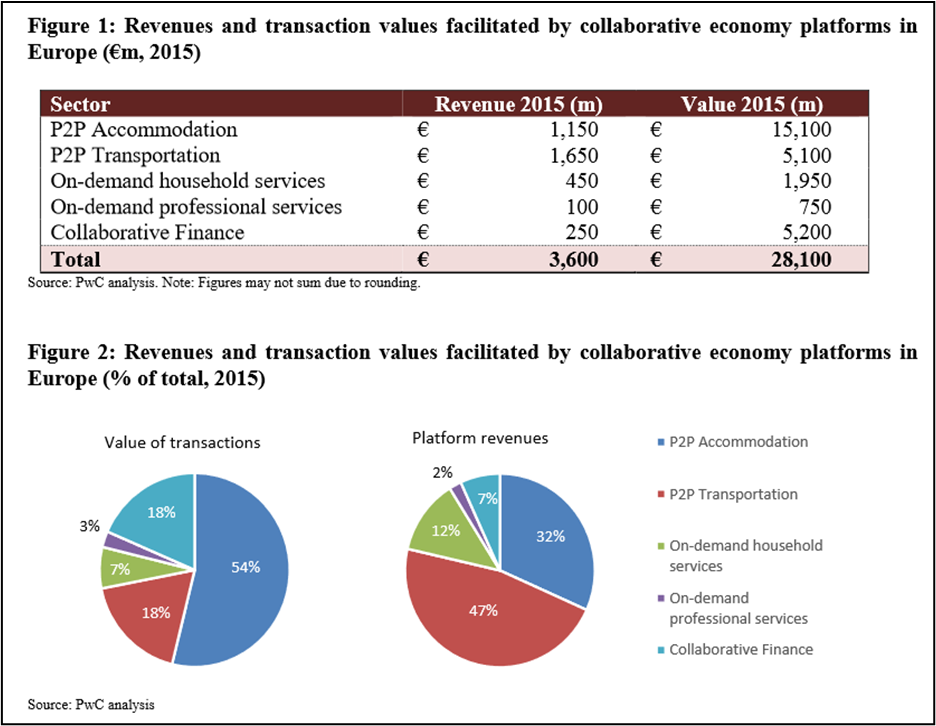
Source:Vaughan, Daverio (2016)
The potential for development of the sharing economy in the field of mobility, as well as its importance in solving related problems, is also supported by the global trends of decentralization, urbanization and population growth in cities. The World Bank estimates that by 2050, about 2/3 of the world’s expected population will live in urban areas. The challenge of ensuring mobility for all does not arise from population growth alone. Today, urban expansion is represented by the “urban sprawl model”. This refers to low population density in urban areas, promoted by cultural changes and an increase in income levels. Modern cities spatially occupy an ever-increasing area, resulting in ever-increasing distances between locations of urban activities, i.e., an increase in travel. As this need for mobility is largely satisfied by car, the negative consequences are noticeable, and many cities in the world today are characterized by strong expansion, rapidly growing motorization, inadequate public transport systems, pollution and congestion of transport infrastructure. The excessive use of private vehicles simply leads to a loss of economic productivity, the destruction of the environment, and the restriction or even total impossibility of accessibility for all citizens. (Zavitsas et al., 2010;Mohan, 2009) The same is true of the broader transportation system, i.e., long-distance travel, where excessive reliance on the irrational use of private vehicles causes almost the same environmental, economic, and social problems.
Experts agree that achieving sustainability requires a significant reduction in the use of private cars and a shift to public transportation, i.e., more efficient forms of mobility. However, there is also agreement that the private car has clear advantages over other modes of transport, especially traditional public transport, e.g. flexibility, comfort, accessibility, availability, etc. The question therefore arises as to how these conflicting requirements can be reconciled. The answer could be found, among other things, in the sharing economy. Indeed, a closer analysis shows that the problem lies not only in the number of cars, but also in the way they are used. Passenger cars are out of use most of the time, i.e. parked somewhere. In practise, depending on the purpose and destination, they are used only 5% of the total time. Moreover, when they are used, even in this small part of the time, they are used extremely inefficiently, as their utilisation rate is far below 50%. This is especially true in developed countries, where the average number of passengers in a passenger car is less than two, although the usual capacity is five. The European Environment Agency notes that national surveys have shown that passenger car utilisation is steadily decreasing, mainly due to a continuous decrease in household size and an increase in the number of car ownersGraph 2). From the above, the development potential of the sharing economy in this sector is clear, but also the need for its promotion in order to solve the problems of the transport system, i.e. the economic and environmental sustainability of society, in a way that is acceptable to the population.
In recent decades, the contribution of shared mobility has increased significantly, and with it the need to understand how it can be effectively integrated into transportation systems in social, environmental, and economic terms. This task is complex and challenging due to the diversity of technical, technological, and economic models and performance modalities. Shared mobility is an “umbrella term” that refers to a wide range of innovative transportation modes (Figure 1).
From an economic point of view and based on the business models applied, companies operating in this field can be divided into two main groups. The first group consists of companies that base their business on an online platform (apps) that primarily coordinates the organization and execution of rides, such as Uber or BlaBlaCar. The second group consists of companies whose business is based on assets, i.e. a fleet of cars, e-scooters or bicycles that they make available to users, such as Spin City or Bolt. However, even in the latter case, the use implies the use of appropriate digital platforms, i.e., the application of information and communication technologies. In fact, as in other areas of the sharing economy, it was precisely these that provided an additional incentive or enabled the development of innovative business models, as numerous authors noted.
In recent years, the sharing economy has been developing dramatically due to the widespread use of ICT (Botsman, Rogers, 2010; Gansky, 2010; Harris, Gorenflo, 2012 inMouratidies et al, 2021:7). Information and communication technologies (ICTs) have enabled the growth of so-called “collaborative consumption,” asHamari et al. (2016:2048) point out. In parallel with the development of information technologies, the growth of Web 2.0 has enabled the development of online platforms that promote user-generated content, sharing, and collaboration (Kaplan, Haenlein, 2010). Regarding transport, information and communication technologies are dynamically changing this field in very different ways, affecting transport modalities, infrastructure, but also users’ behavior in terms of satisfying their mobility needs. Based on a literature review, insights from the 2015 Disrupting Mobility Conference (MIT, Cambridge MA, November 2015), and several interviews with experts in the field, Snellen and Hollander identified seven major changes with different impacts (Snellen, Hollander, 2017). One of them refers precisely to the development of new transport options enabled by ICT, i.e., expanding the possibilities and/or facilitating the use of different modes of transport. The simplicity of car sharing has been greatly enhanced by web applications that indicate where cars are available and at what price, so that it only takes a few clicks to order an Uber cab, for example. The expected future development combines the possibilities of ICT with the concept of car sharing. Self-driving vehicles, currently the most discussed technological innovation in transportation, can theoretically improve this process because they remove some of the current barriers to car sharing, i.e., they make the process easier because the car comes to the user instead of the user having to pick it up somewhere.
Standing et al. (2008) identify facilitators of the sharing economy in transport emphisized that several of the facilitators are interrelated because they relate to conditions that revolve around changes to behaviour brought about by developments in technology and the Internet (Table 1). Facilitation refers to factors that support a change but are not the reason or cause for the change (Standing et al., 2018).
Source:Standing et al. (2018)
From the above, it is clear that digital platforms for sharing transportation play a multi-faceted role and are important when it comes to choosing to use the service, whether in the form of a mobile app and/or a website. Aside from ease of use in terms of fulfilling the basic purpose of connecting and arranging a ride, they can also significantly influence usage by building trust. Recommendations from friends, or in their absence from others, are often critical to the decision to buy or use a product or service. When sharing transportation, this aspect is even more important, as passengers entrust their personal safety to an unknown driver. Shared mobility corresponds in some ways to our usual behavior, but when it goes beyond the circle of family or acquaintances, there is resistance. From this it can be concluded that the problem of acceptance is not a question of convenience, possible temporal adjustment, etc., but almost exclusively a question of trust. Ridesharing with social contacts (i.e., ‘friends’) is substantially more accepted than with strangers. (Wang et al., 2017)
The biggest success factor in the sharing economy is an online review and feedback system where buyers and sellers can rate each other (Bae, Koo, 2018). A networked system of feedback and available reviews can improve trust between participants.Luca (2016) states that user-generated online reviews have high credibility among customers and are an essential part of the decision- making process. With the help of this system, sharing is less risky due to the use of rating and reputation mechanisms. (Tadelis, 2017)
Companies such as Uber, Lyft and BlancRide have all diligently tackled trust issues for drivers and passengers by implementing features such as two-way feedback. According to one study, 75% of people trust peer reviews, which have become the foundation for how individuals evaluate holiday destinations, restaurants, consumer goods and even people. This feedback system addresses many inherent trust issues of entering a stranger’s car, and is very strict. For instance, if an Uber driver’s rating drops below 4.6 out of 5, they are at risk of being deactivated. (Nicoll, Armstrong, 2016).
Most digital ridesharing platforms rely on user feedback to provide safe ridesharing services to other users, turning them into partners and participants in the business process itself. In this way, they build trust and loyalty among existing users, but also attract new users.
This topic is likely to becoming increasingly important as distrust of others increases among younger generations. In response to a long-standing social science survey question, “Generally speaking, would you say that most people can be trusted or that you can’t be too careful in dealing with people,” just 19% of Millennials say most people can be trusted, compared with 31% of Gen Xers, 37% of Silents and 40% of Boomers (Taylor et al., 2014.).
4. RESULTS OF THE EMPIRICAL RESEARCH
4. 1 Research methodology
The aim of the empirical part of the study was to determine the respondents’ views on ridesharing and their evaluation of the digital platforms used for this purpose in the Republic of Croatia.
This is a quantitative study in which the data were collected using a questionnaire. The unit of analysis is the individuals who voluntarily responded to the questionnaire. The method used in the study was a survey conducted as an online questionnaire through social networks.
The questions of the questionnaire are divided into 3 parts. The first part of the questionnaire collected the demographic data of the respondents, the second part used closed questions where the respondents selected one of the offered answers regarding their attitude towards shared mobility, and the third part of the questionnaire used a 5-point Likert scale to express the respondents’ attitude towards each digital platform they use and prefer. Using the Likert scale, respondents expressed their level of agreement (1= I do not agree at all, 2= I mostly disagree, 3= I neither agree nor disagree, 4= I mostly agree, 5= I fully agree). The survey was conducted in 2021 on a sample of 172 respondents.
4. 2 Sample characteristics
Of the 172 respondents, 38% (66) were male and 62% (106) were female. In terms of age in years, 73% of the respondents were under 35 years old. About 66% of the respondents had a university degree. In addition, about 51% of the respondents are employed (Table 2).
Source: Author’s research
4. 3 Research Results
4. 3. 1 Results of descriptive statistics - attitudes toward the use of shared mobility
Of the 172 completed questionnaires, 68 respondents (39.5%) use ride-sharing services, while 104 (60.5%) do not. At the same time, 65% of these respondents also do not plan to use them in the future. However, looking at the factors that could influence this decision, it appears that there is still additional scope for transport and/or social policy measures to influence it.
Even if the possibilities of influence are modest through the development of an awareness of the need to preserve the environment by reducing the use of private vehicles and the reliability and safety of specialized applications, i.e., by improving them, the economic aspect must also be taken into account (4). The financial context is one of the key factors in numerous studies, either directly expressed as money saved in the context of influencing user decisions, or indirectly through the characteristics of the environment such as fuel prices, parking fees, etc., or the level of income as personal characteristics of a person. In this study, economics, i.e. the financial aspect, is also mentioned as a main motivating factor (Graph 3). This opens up possibilities for influence through traffic regulation measures, especially in the urban transport system, e.g. through parking fees and the like.
Regarding the level of education, the results of the conducted research indicate a greater use of the service by users with higher levels of education (29% of respondents with secondary education and 47% of those with university degrees have used ridesharing services).
When analyzing the reasons that could motivate respondents to use the ride-sharing service, 64% of male respondents and 43% of female respondents could be motivated by financial savings. It is interesting to note that 21% of female respondents and only 5% of male respondents could be motivated by awareness of the need to protect the environment.
As expected, of the 68 respondents who use the service, very few use it as a basic means of ensuring mobility. Only three respondents use the service almost daily and a smaller number regularly or several times a month (13), while most respondents use the service occasionally (52).
Regarding the perception of the shortcomings of the ride-sharing service, the assumption of a significant influence of the personal feeling of safety was confirmed. However, looking at the gender structure among the users of the ridesharing service who indicated questionable safety as one of the main deficiencies, almost 90% are women. For the other deficiencies, there is no significant difference in terms of the gender of the respondents. Looking at the other shortcomings mentioned, it is clear how important the efficiency and choice of digital platforms are in planning and organising rides, but especially the presence and quality of their rating system and user feedback. (Graph 4)
4. 3. 2 Results of descriptive statistics – Attitudes towards digital ridesharing platforms
Although a portion of respondents most often use the traditional method for sharing rides through personal acquaintances and contacts (12%) or social networks (10%), specialized applications are the most commonly used (78%).
Most respondents use the BlaBlaCar application (53) and significantly fewer use Uber (23) or Facebook (FB group - I am looking for a ride - 17). Because this question gave posibilities for multiple choices, additionally examined users’ preferences for individual platofrms, including respondents who indicated personal contacts and acquaintances as the basic way to order rides.
Of course, since this result is highly dependent on the respondent’s type of ride (urban or intercity), i.e., the availability of Uber service in certain areas, it is not possible to draw a conclusion about the quality of specific platforms based on the above data. However, it is interesting to note that BlaBlaCar is the most frequently used application by the respondents, but it is also preferred by those who use multiple platforms. (Graph 5)
Given the very small number of respondents using all digital platforms, it was not possible to evaluate the individual aspects in comparison to each other, and respondents evaluated the chosen preferred method for arranging rideshares.
In terms of the basic function of finding, contracting and executing a ride, specialized platforms offer more options, as expected, as users recognized. With the exception of user-friendliness, users consistently rated contracting via Facebook significantly lower. In contrast, the specialized platforms Uber and BlaBlaCar are rated very well by users with slight differences (rating range 4.2 - 4.8 and 4.3 - 4.8, respectively). (Graph 6)
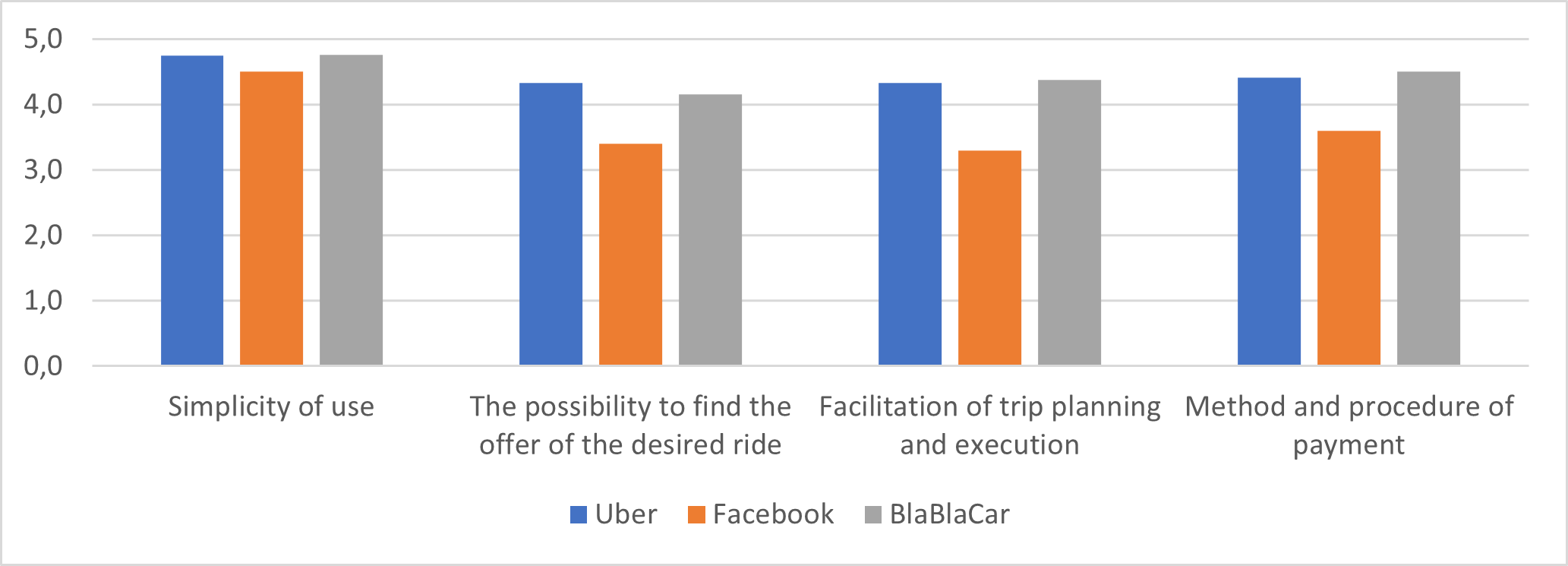
Source: Author's research
Regarding another important aspect, safety, on the one hand the expected results have been obtained, but on the other hand contradictions can be observed. (Figure 8) It is to be expected that safety is rated very low when renting a ride via Facebook. Uber is even rated slightly better than BlaBlaCar, considering that the driver has to meet certain requirements. However, it is interesting to note the significant difference in the rating of issues related to safety and security of drivers and passengers, as well as issues related to the possibility to evaluate drivers. The possibility and transparency of driver (and user) ratings offered by specialized platforms is one explanation for why they are rated significantly higher than Facebook groups. However, in the case of Facebook, the perception of safety and security is rated higher than the ability to rate drivers, while the opposite is true for specialized applications. This suggests that the ability to review driver and user ratings offered by specialized applications is certainly an important factor in perceptions of safety, and thus contributes significantly to the acceptance and development of ridesharing as a form of mobility. However, they also have a limited scope, as perceptions of safety are obviously very complex and largely determined by individuals’ general attitudes toward trusting others. In other words, the acceptance of ridesharing will also depend on elements outside the system itself, related to the attitudes and habits of the population, i.e., sociological, cultural, and other social characteristics of a given region or country.
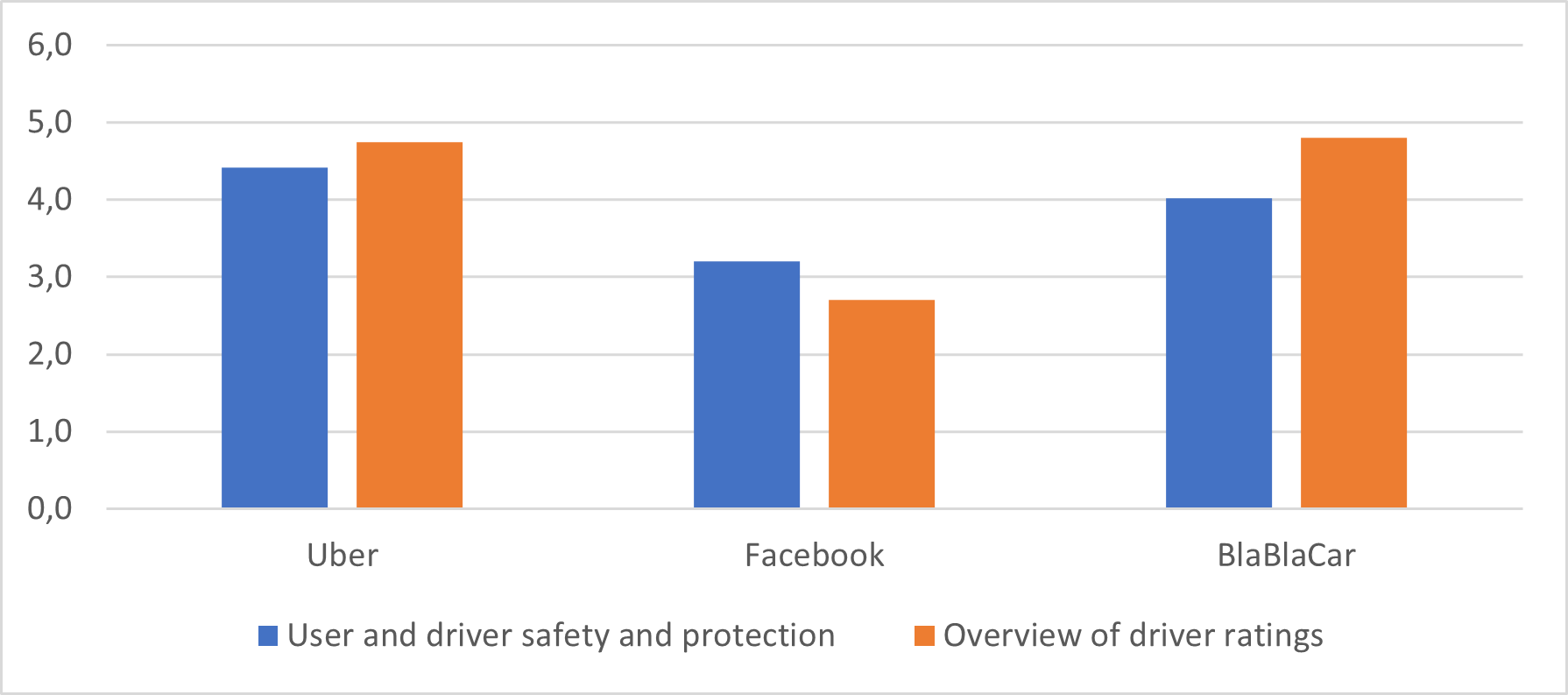
Source: Author's research
Regarding the overall usefulness of the platform, it can be noted that users of the BlaBlaCar application are more satisfied.
4.3.3 Results comparision and limitations
The results of the conducted research are partly consistent with the findings of previous research on respondents' attitudes towards shared mobility services, although some of the research differed in terms of the type of shared mobility that was the focus of the research (carsharing, ridesharing, carpooling, etc.). For example,Naletina et al. (2021) conducted a study in the Republic of Croatia with a similar demographic sample that focused on carsharing services in the capital city, where there were providers of such services. According to their study, 15.6% of respondents used this service.Naletina et al. (2021) cited lower costs (65.4%) as the most common reason for using carsharing.Kovač (2022) studied the attitude of customers towards the use of sharing economy services in public transport in the period of the pandemic in the Republic of Croatia (carsharing, ridesharing, carpooling). Also in her research, the financial motive was confirmed as the main motive for changing the transport habits (63.44%) of the respondents, while the environmental impact was not considered as a significant factor. This is in line with the results presented in this paper. According to a research conducted byRamos et al. (2020) on the use of car sharing services in seven European countries, in which 5,214 people were interviewed, 29% of the respondents were users of this service. In terms of demographic characteristics, this research confirmed for the most part no significant difference between users and non-users of shared mobility, except in Italy, where users are on average younger (up to 39 years old) than non-users. Only a higher proportion of shared mobility users (72.5%) who have a higher level of education (university degree or more) was confirmed, which is consistent with the results of this research. In the mentioned research, clusters of shared mobility users and non-users were formed in terms of their transport habits, political attitudes, attitudes towards the environment and motives that encourage (or could encourage) them to use this service. The conclusion of this European research is that it is necessary to develop different communication messages with regard to the specific characteristics of the target group in order to raise awareness of the need for sustainable transport habits with a positive impact on the environment, thus influencing the decision to buy their own car or a second or third car in the family. Increasing the use of shared mobility services could influence transport habits and create space for more environmentally sustainable transport processes. There is room for further research. The results of this research are also consistent with Ipsos MORI’s report for the Department for Transport (2019), according to which the most important factors influencing the decision to use shared mobility are: lower cost, convenience and safety of service (users are not willing to compromise on these factors), and comfort and positive environmental impact (this factor is not as important as the previous ones). In the above studies, the part related to the use of digital platforms was not considered.
The limitations of this research relate to the sample size (172 respondents), as well as the age distribution of the respondents and the way the questionnaire was distributed via social networks. For this reason, the results of the conducted research cannot be considered representative and no generalized conclusions can be made about the users of the shared transportation service in the Republic of Croatia. In the part of the research on the use of shared mobility services, the results can be compared with previously conducted research, in contrast to the part that refers to the attitudes of users towards the available digital platforms in the Republic of Croatia. However, the obtained results correspond with theoretical insights in terms of expected higher user satisfaction with specialized digital platforms that are generally used in the sharing economy, especially with regard to ease of use, ensuring a higher level of security and the possibility of evaluating services, as well as insights into the evaluations of previous users.
5. CONCLUSION
The sharing economy as a business model has become a widely accepted social phenomenon in many areas in recent years. It is estimated that the total value of the sharing economy market will be around 335 billion euros by 2025. Its success is no accident, as it can benefit consumers, individuals, the economy and society as a whole. One of the driving sectors is transport, which is also a good example of the potential positive impact on society as a whole. Aside from the negative impacts mentioned in the literature, which are primarily due to inadequate regulation, there are clear potential benefits to society as a whole due to the positive environmental and other sustainability impacts of the transportation system, in addition to the benefits to those directly involved in shared mobility. Shared mobility, one of the segments of the sharing economy, has extremely high potential to positively impact the transportation system, which is facing major challenges due to the rapid increase in motorization and the number of private vehicles that are affecting the quality of life of the population in environmental and every other way. Given this potential, it is not surprising that one of the best-known examples of disruptive innovation, along with Airbnb, is currently Uber. Although the concept of sharing goes back a long way in human history, it was the development and application of ICT technologies that changed the way people communicate with each other and provided the necessary additional impetus that led to the spread of this economic model.
In the Republic of Croatia there are almost all forms of shared mobility. Although there are more and more examples of vehicle sharing, currently mainly bicycles and e-mobiles, ridesharing are the most important segment in a broader context, as it is also available outside the major urban centers. To date, no comprehensive, targeted research has been conducted that would provide clear answers about the prevalence of shared mobility use in the population. This research also does not meet the criterion of representativeness of the sample, but it provides results that are comparable to previous research.
In this study, 39.5% of respondents used ridesharing, most of them occasionally, and only a few regularly on a monthly or daily basis. Interestingly, an almost identical percentage of respondents were not willing to use the service in the future. When considering the factors that might cause a change in this attitude, cost-effectiveness, i.e., financial savings, is at the forefront, i.e., the most important perceived motivating factor. Although a portion of respondents most often use the traditional mode of personal acquaintances and contacts to arrange rideshares, the largest number use digital platforms, with specialized mobile applications predominating. BlaBlaCar is the most frequently used application, but is also preferred by those who use multiple applications (ways) to arrange rideshares. In terms of the basic function of searching, concluding and executing a rideshare, specialized platforms offer more possibilities, which is also seen as such by the users. All aspects, with the exception of ease of use, were consistently rated significantly lower when using Facebook. In terms of the general usefulness of the digital platforms, the ratings are similar, but higher satisfaction is observed among users of the BlaBlaCar application (4.8)
The most interesting result relates to the aspect of safety. In addition to the expected significantly lower rating of safety when renting a ride through Facebook compared to Uber and BlaBlaCar, it is interesting to note a significant difference in the rating of safety of drivers and passengers, as well as questions about the possibility of rating and reviewing driver ratings. The possibility and transparency of driver (and user) ratings offered by specialized platforms are one explanation for why they are rated significantly better than Facebook groups. Finally, with Facebook, the ability to rate the driver was rated very poorly by respondents, but interestingly, the perception of safety and security was actually rated better. The opposite is true for specialized platforms. User safety and protection were rated lower than the perceived ability to track user characteristics through the rating system. This suggests that the ability to evaluate and review user ratings is an important factor in the perception of safety and thus certainly contributes significantly to the acceptance of the concept of shared mobility. But also that the scope is limited, as the perception of safety and security is obviously very complex. This is also confirmed by the results on users’ perceived shortcomings of the sharing service. Questionable security is the most frequently mentioned shortcoming expected by potential users, but not by actual users. In other words, specialized digital platforms, through the rating and trust-building system, can significantly contribute to overcoming fears related to personal safety and thereby accepting the concept of ridesharing, but success is highly dependent on the general attitude of individuals toward trusting others. Therefore, the acceptance of ridesharing also depends on elements outside the system itself related to the attitudes and habits of the population, i.e., sociological, cultural, and other social characteristics of a particular person, geographic area, or country.
In order for the benefits of the sharing economy in the context of transport or shared mobility to be as great as possible for the direct users, but also for the broader socio-economic-ecological context, it is necessary to conduct comprehensive longitudinal researches with clearly defined objectives and the possibility of monitoring the impact of the measures taken. Further research in the Republic of Croatia should definitely aim at a structured, representative sample of respondents, on the basis of which generalizable conclusions can be drawn. In this way, measures could be created that would have a positive impact on the transport system, sustainability, i.e. the socio-economic environment, and reduce the negative impact and attitude towards this type of service. Intermediaries or owners of digital platforms could use the information from such research to improve their own services.

